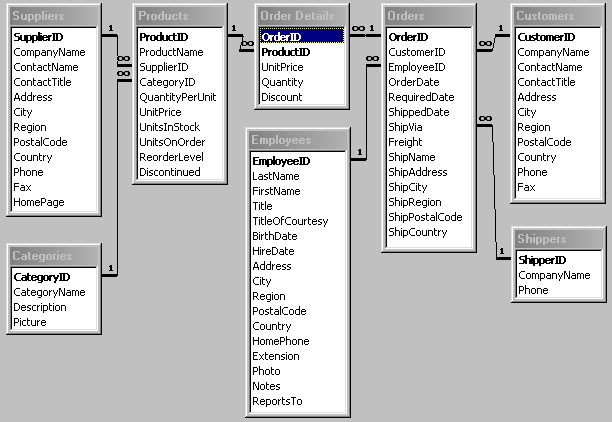Follow these directions to export the Northwinds database to MySQL.

Use the database to answer these queries:
-
Get supplier names and order ID for all orders.
SELECT Suppliers.CompanyName, Orders.OrderID
FROM Suppliers, Products, Order_Details, Orders
WHERE Suppliers.SupplierID=Products.SupplierID
AND Products.ProductID=Order_Details.ProductID
AND Order_Details.OrderID=Orders.OrderID;...or...
SELECT Suppliers.CompanyName, Orders.OrderID
FROM Suppliers
INNER JOIN Products USING (SupplierID)
INNER JOIN Order_Details USING (ProductID)
INNER JOIN Orders USING (OrderID); -
Get supplier name, order ID and product name for all orders supplied by "Tokyo Traders."
SELECT Suppliers.CompanyName, Order_Details.OrderID, Products.ProductName
FROM Suppliers, Products, Order_Details
WHERE Suppliers.SupplierID = Products.SupplierID
AND Products.ProductID = Order_Details.ProductID
AND Suppliers.CompanyName = "Tokyo Traders";...or...
SELECT Suppliers.CompanyName, Order_Details.OrderID, Products.ProductName
FROM Suppliers
INNER JOIN Products USING (SupplierID)
INNER JOIN Order_Details USING (ProductID)
WHERE Suppliers.CompanyName = "Tokyo Traders"; -
Get supplier name, order ID, product name, and dollar value of the amount of that
product ordered for each order supplied by "Tokyo Traders."
SELECT Suppliers.CompanyName, Order_Details.OrderID, Products.ProductName,
((Order_Details.UnitPrice*Order_Details.Quantity) * (1-Order_Details.Discount)) as "$Value"
FROM Suppliers, Products, Order_Details
WHERE Suppliers.SupplierID = Products.SupplierID
AND Products.ProductID = Order_Details.ProductID
AND Suppliers.CompanyName = "Tokyo Traders";...or...
SELECT Suppliers.CompanyName, Order_Details.OrderID, Products.ProductName,
((Order_Details.UnitPrice*Order_Details.Quantity) * (1-Order_Details.Discount)) as "$Value"
FROM Suppliers
INNER JOIN Products USING (SupplierID)
INNER JOIN Order_Details USING (ProductID)
WHERE suppliers.CompanyName = "Tokyo Traders"; -
Get the shipper name and supplier name for all orders shipped by "Speedy Express."
SELECT Shippers.CompanyName, Suppliers.CompanyName
FROM Shippers, Orders, Order_Details, Products, Suppliers
WHERE Shippers.ShipperID = Orders.ShipVia
AND Orders.OrderID = Order_Details.OrderID
AND Order_Details.ProductID = Products.ProductID
AND Products.SupplierID = Suppliers.SupplierID
AND Shippers.CompanyName = "Speedy Express";...or...
SELECT Shippers.CompanyName, Suppliers.CompanyName
FROM Shippers
INNER JOIN Orders ON Shippers.ShipperID = Orders.ShipVia
INNER JOIN Order_Details USING (OrderID)
INNER JOIN Products USING (ProductID)
INNER JOIN Suppliers USING (SupplierID)
WHERE Shippers.CompanyName = "Speedy Express"; -
List the shipper name and the number of orders shipped by each shipper.
SELECT Shippers.CompanyName, COUNT(Orders.OrderID) as "Number of Orders"
FROM Shippers, Orders
WHERE Shippers.ShipperID = Orders.ShipVia
GROUP BY Shippers.CompanyName;...or...
SELECT Shippers.CompanyName, COUNT(Orders.OrderID) as "Number of Orders"
FROM Shippers
INNER JOIN Orders ON Shippers.ShipperID = Orders.ShipVia
GROUP BY Shippers.CompanyName; -
Display the quantity ordered of each product.
SELECT ProductName, Sum(Quantity) AS "Quantity Ordered"
FROM Products, Order_Details
WHERE Products.ProductID = Order_Details.ProductID
GROUP BY ProductName;...or...
SELECT Products.ProductName, Sum(Quantity) AS "Quantity Ordered"
FROM Products
INNER JOIN Order_Details USING (ProductID)
GROUP BY ProductName; - Write a query that shows how many orders are associated with each customer ID.
Note that the customerID field is replaced with the Customerís name. Why is that?
SELECT Orders.CustomerID, COUNT(Orders.OrderID) as "Number of Orders"
FROM Orders
GROUP BY Orders.CustomerID; -
Total inventory (dollar value) on hand by category.
SELECT CategoryID, SUM(UnitPrice * UnitsInStock) AS "Inventory Value"
FROM Products
GROUP BY CategoryID; -
Show the company names of all customers that have ordered the product "Aniseed Syrup."
SELECT Customers.CompanyName
FROM Customers, Orders, Order_Details, Products
WHERE Customers.CustomerID = Orders.CustomerID
AND Orders.OrderID = Order_Details.OrderID
AND Order_Details.ProductID = Products.ProductID
AND Products.ProductName = 'Aniseed Syrup';...or...
SELECT Customers.CompanyName
FROM Customers
INNER JOIN Orders USING (CustomerID)
INNER JOIN Order_Details USING (OrderID)
INNER JOIN Products USING (ProductID)
WHERE Products.ProductName = 'Aniseed Syrup'; -
Show the company names of all suppliers who have discontinued products.
SELECT DISTINCT Suppliers.CompanyName
FROM Suppliers, Products
WHERE Suppliers.SupplierID = Products.SupplierID
AND Products.Discontinued;...or...
SELECT DISTINCT Suppliers.CompanyName
FROM Suppliers
INNER JOIN Products USING (SupplierID)
WHERE Products.Discontinued; -
Show the total dollar value of all the orders we have for each customer (one dollar
amount for each customer). Order the list in descending order.
SELECT Orders.CustomerID,
CONCAT('$', FORMAT (SUM((Order_Details.UnitPrice * Order_Details.Quantity) * (1 - Order_Details.Discount)),2)) AS Total
FROM Orders, Order_Details
WHERE Orders.OrderID = Order_Details.OrderID
GROUP BY Orders.CustomerID
ORDER BY SUM((Order_Details.UnitPrice *
Order_Details.Quantity) * (1 - Order_Details.Discount)) DESC;...or...
SELECT Orders.CustomerID,
CONCAT('$', FORMAT (SUM((Order_Details.UnitPrice * Order_Details.Quantity) *
(1 - Order_Details.Discount)),2)) AS Total
FROM Orders
INNER JOIN Order_Details USING (OrderID)
GROUP BY Orders.CustomerID
ORDER BY SUM((Order_Details.UnitPrice *
Order_Details.Quantity) * (1 - Order_Details.Discount)) DESC; -
Show all products that have UnitsInStock that are below the ReorderLevel.
SELECT ProductName
FROM Products
WHERE UnitsInStock < Reorderlevel; -
What are the last names of all employees born before Jan 1, 1960?
SELECT LastName
FROM Employees
WHERE BirthDate < "1960-1-1"; -
List the supplier name and city for all suppliers based in the United States.
SELECT CompanyName, City
FROM Suppliers
WHERE Country = "USA"; -
List the supplier name and URL for all suppliers that have a home page.
SELECT CompanyName, HomePage
FROM Suppliers
WHERE HomePage IS NOT NULL; -
Using one of the special operators, list the supplier name and country for
all suppliers based in an English-speaking county.
SELECT CompanyName, Country
FROM Suppliers
WHERE Country in ("USA", "UK", "Australia", "Canada"); -
Using one of the special operators, list the product name and price for
all products that sell for as little as $10 and as much as $20.
SELECT ProductName, UnitPrice
FROM Products
WHERE UnitPrice BETWEEN 10.00 AND 20.00; -
List the company name for all customers whose company name falls between 'L' and 'O', inclusive.
SELECT CompanyName
FROM Customers
WHERE CompanyName Between "L*" AND "P*";MySQL is inclusive at beginning but not end.
-
List the last name and title for all employees who work in sales.
SELECT LastName, Title
FROM Employees
WHERE Title LIKE "Sales%";
